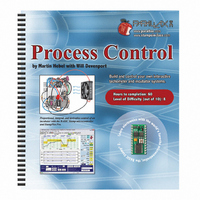122-28176 Parallax Inc, 122-28176 Datasheet - Page 290

122-28176
Manufacturer Part Number
122-28176
Description
GUIDE STUDENT PROCESS CONTROL
Manufacturer
Parallax Inc
Specifications of 122-28176
Accessory Type
Manual
Product
Microcontroller Accessories
Lead Free Status / RoHS Status
Contains lead / RoHS non-compliant
For Use With/related Products
Propeller Education (PE) Kit
Lead Free Status / RoHS Status
Lead free / RoHS Compliant, Contains lead / RoHS non-compliant
- Current page: 290 of 330
- Download datasheet (11Mb)
Page 280 · Process Control
Analyzing our run in Figure 8-13, we see that it required about 5 minutes to stabilize at
the 50% bias temperature of around 98 °F.
Changing the %Bias to 60% and then to
55%, the temperature slowly drifted and stabilized closer to the setpoint.
Is this system acting as a closed-loop? Not really. Just as in Chapter 6, we are manually
manipulating the drive to control the system. As seen from the bottom graphs, the only
time that the %Dt (Drive Total) changes is when we adjust the bias. Following a
disturbance at 13 minutes, the system required approximately 7 minutes to recover and
stabilize once again at the setpoint, though slightly higher - the room's winter heater may
have raised temperature in the room, slightly changing conditions.
At 55% drive, the energy added by the heater equals the amount of energy lost at the
setpoint to maintain the system stable. But, if the air around the incubator becomes
cooler, greater energy escapes resulting in a lower stabilized temperature.
Program Discussion
The program IncubatorPID-SP.bs2 and macro sic_pc_pid_sp_calc.spm work together to
control the drive to the heater. Upon BASIC Stamp reset, the temperaure limits for
monitoring and the drive time are read. With each loop, the raw data is sent to StampPlot
and the PID calculations and plotting are performed. The BASIC Stamp reads the total
drive percent and drives the heater based upon that value. StampPlot can perform
floating point math and handle very large numbers.
All integral and derivative
calculations are based on the real time that they arrived. One drawback is that it takes
time to send data from the BASIC Stamp, allow StampPlot to perform calculations, and
accept the returning data. With a drive time of 1 second, typical times of ∆t were 1.75 to
2.10 seconds, and may be slower depending on the speed of your computer. Also, the
incubator will not work unless StampPlot is running.
Related parts for 122-28176
Image
Part Number
Description
Manufacturer
Datasheet
Request
R

Part Number:
Description:
MANUAL FOR SUMOBOT
Manufacturer:
Parallax Inc
Datasheet:

Part Number:
Description:
GUIDE STUDENT SMART SENSORS
Manufacturer:
Parallax Inc
Datasheet:

Part Number:
Description:
MANUAL PROPELLER
Manufacturer:
Parallax Inc
Datasheet:

Part Number:
Description:
LEAD WIRES FLYING CABLE III/IV
Manufacturer:
Xilinx Inc
Datasheet:

Part Number:
Description:
BOARD ADAPTER AND FLY LEADS
Manufacturer:
Xilinx Inc
Datasheet:

Part Number:
Description:
PLATFORM CABLE USB II
Manufacturer:
Xilinx Inc
Datasheet:

Part Number:
Description:
KIT STARTER COOLRUNNER-II BUNDLE
Manufacturer:
Xilinx Inc
Datasheet:

Part Number:
Description:
Microcontroller Modules & Accessories DISCONTINUED BY PARALLAX
Manufacturer:
Parallax Inc

Part Number:
Description:
Microcontroller Modules & Accessories DISCONTINUED BY PARALLAX
Manufacturer:
Parallax Inc

Part Number:
Description:
BOOK UNDERSTANDING SIGNALS
Manufacturer:
Parallax Inc
Datasheet:

Part Number:
Description:
BOARD EXPERIMENT+LCD NX-1000
Manufacturer:
Parallax Inc
Datasheet:

Part Number:
Description:
IC MCU 2K FLASH 50MHZ SO-18
Manufacturer:
Parallax Inc
Datasheet:












